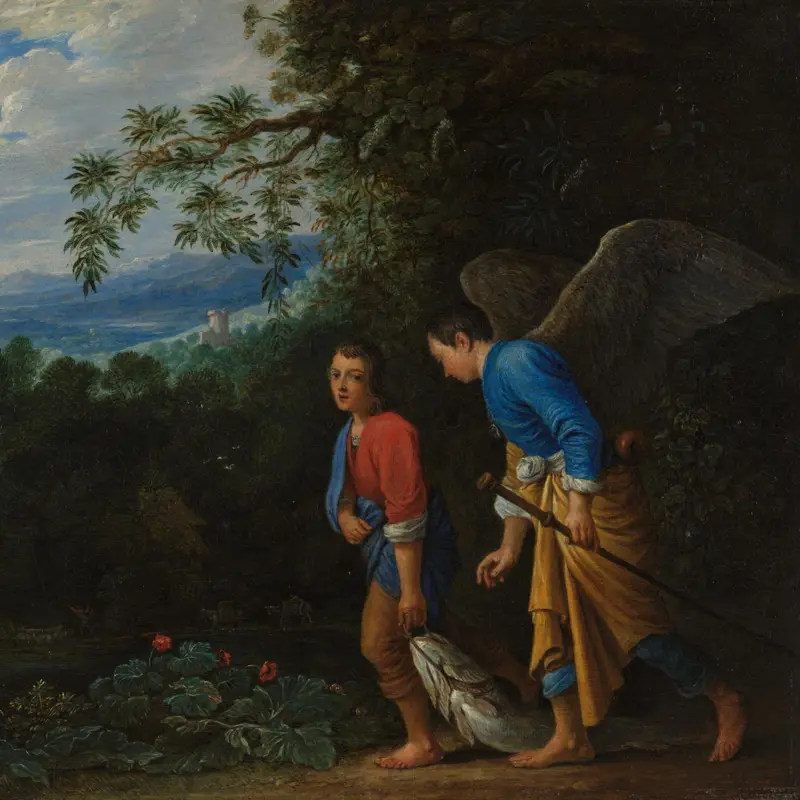Adam Elsheimer, 'Saint Lawrence prepared for Martyrdom', about 1601-2
About the work
Overview
On the orders of the pope, Saint Lawrence, a deacon of the early Christian Church, distributed church property to the poor in Rome. When the Roman authorities discovered what he was doing, they ordered him to hand over the treasures to the city. He refused, and when pressed to give up his Christian faith or face execution, he chose death. He was killed in AD 258.
Here the saint is being stripped of his clothes in preparation for being roasted alive; to the right, two men stoke a fire beneath a gridiron. The figure in the red and gold robes is the Roman Emperor Decius. A Roman priest in a dark hooded cloak stands between emperor and saint, and points to a statue of Hercules, a mythological hero of antiquity. Lawrence’s expression suggests he is in a state of spiritual ecstasy: he looks towards an angel who points to heaven, the inspiration of his strength.
Key facts
Details
- Full title
- Saint Lawrence prepared for Martyrdom
- Artist
- Adam Elsheimer
- Artist dates
- 1578 - 1610
- Date made
- about 1601-2
- Medium and support
- oil on copper
- Dimensions
- 26.7 × 20.6 cm
- Acquisition credit
- Wynn Ellis Bequest, 1876
- Inventory number
- NG1014
- Location
- Room 27
- Collection
- Main Collection
- Previous owners
- Frame
- 17th-century Dutch Frame
Provenance
It is usually assumed that the undated etching by Pieter Soutman (1580–1657) is likely to have been made after the original in Antwerp in the period 1625–50.
According to Sandrart, Count Johann von NassauSaarbrücken-Idstein (1603–1677) owned an ‘original’ painting by Elsheimer of this subject in his Kunstkammer at Idstein Castle: ‘No less artistic is his painting / how St Lawrence is being undressed in front of the judge / on their order to be roasted on the gridiron / near the represented idol / but he turns devoutly to the sky / with indescribable effects the original of this is now in the highborn Reichs-Grafen and Lord Herrn Johann von Nassau / zu Saarbrucken in his residence to be seen among many other curiosities.’ This seems to be the painting by Elsheimer referred to by Matthäus Merian the Younger (1621–1687) in a letter to Count Johann in 1661. When Count Johann died in 1677, his last will decreeing that his collection be kept intact seems to have been largely observed by his son Georg August (1665–1721). An inventory of the collection from 1678 is the last reference to the Elsheimer in Idstein: ‘A small piece by Elshammer the history of Laurenzio’. With the death of Georg August in 1721 his estate was divided and the collection was finally dispersed on the death of his heirs in 1723 and 1728. If the painting remained in the collection after Count Johann’s death in 1677 it cannot be identified with the painting of Saint Lawrence by Elsheimer recorded in Antwerp in 1682 in the collection of Diego Duarte (before 1616–1690).
A painting which may be Elsheimer’s original was recorded in the sale of the poet, painter and collector Sybrand Feitama II (1694–1758) at Amsterdam, 16 October 1758, lot 64. A painting by Elsheimer of the Martyrdom of Saint Lawrence was in the Herman Cornelius Johan van Eversdijk (1727–1765) sale at The Hague, 28 May 1766, lot 2; in the Goodall sale 1772 in London, lot 37; in the Richard Morrison sale in London, 1788; in the Meyer Solomon sale in London, 30 November 1802 and in another London sale in 1818, but in view of the number of copies recorded, as well as the existence of other images of Saint Lawrence by or associated with Elsheimer, it is impossible to be certain which if any of these sale references record the history of NG 1014, and precisely when it came to England. NG 1014 formed part of the bequest of paintings, mostly Dutch, made to the National Gallery by the silk merchant and Liberal MP Wynn Ellis (1790–1875) in 1876.
Additional information
Text extracted from the ‘Provenance’ section of the catalogue entry in Susan Foister, ‘National Gallery Catalogues: The German Paintings before 1800’, London 2024; for further information, see the full catalogue entry.
Bibliography
-
1959Levey, Michael, National Gallery Catalogues: The German Schools, London 1959
-
2001
C. Baker and T. Henry, The National Gallery: Complete Illustrated Catalogue, London 2001
-
2024S. Foister, National Gallery Catalogues: The German Paintings before 1800, 2 vols, London 2024
Frame
This is a seventeenth-century Dutch ebony frame. It has a wide stepped profile with concave and convex moulding, covering roughly five times the area of Elsheimer’s Saint Lawrence prepared for Martyrdom. The painting was initially housed in a gilt fluted hollow frame, later replaced by a reproduction ripple moulding with gold fillets in a wide profile, similar to the current frame.
This frame was fitted to Saint Lawrence prepared for Martyrdom in 2014.
About this record
If you know more about this work or have spotted an error, please contact us. Please note that exhibition histories are listed from 2009 onwards. Bibliographies may not be complete; more comprehensive information is available in the National Gallery Library.



